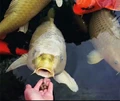
Government of West Bengal has launched a project for increasing farmers’ agricultural income with income from fish farming, that too in an organic way. The state agriculture & fisheries departments have taken up this project mutually in the Malda district which will later spread to other districts too. The venture is part of the state’s Agricultural Technology Management Agency (ATMA) Scheme.
For small farmers, the revenue earned from farming after deducting the cost of raw materials is not profitable. Hence, considering the demand for fish in the state, fishlings are being released in the flooded fields after sowing of paddy. In addition, no pesticides are being allowed for the paddy or any chemicals for helping the fish grow.
The fish varieties being released comprise magur, rohu, catla koi and singhi. The fish will help the crops as they will eat away the weeds and pests that can obstruct the growth of the paddy. Canals & small water bodies have been dug near the plots so that whenever the water levels goes down in fields then the fish could swim across it.

For cultivators, for 6 to 7 months, the fish will grow next to the crops and after the crops are cut & the fishes are caught, the water in the small canals could be used for cultivating vegetables.
Giving details on the cost factor, Malda district project director for the ATMA scheme said, “On 1 bigha of land, at least 1,000 fishlings are released. Only three to four less rows of crops should be planted per plot to accommodate the fish, as that portion is required to cut canals around the plots. And if there is existing small water bodies even that amount of land is not needed to be kept free.
The project director added that “1 bigha of land usually produces 20 - 22 tons of paddy (in case of Malda), whose market rate is Rs 15,000. This isn’t much. But if this is combined with fish farming, a substantial income is guaranteed. Rs 5,000 spent / bigha on cultivating fish will produce about 5 quintals of fish whose market price is Rs 50,000.To make it cheap, cultivation would be done by combining a few plots. This will lead to joint ownership of the projects & in turn decrease the cost of agriculture.”
















